#Serbian revolutionaries
Text
◾Original portraits of some of the Serbian revolutionaries from the 18th and 19th centuries by Serbian painter Urosh Knezhevitsh(srb. Урош Кнежевић/lat. Uroš Knežević) 🇷🇸
◾Officially, the first revolution for liberation from the Ottoman Empire in the Balkans was started by the Serbs in 1804 (and earlier than that there were smaller Serbian revolutions).
▪️Hayduk Velyko Petrovitsh & Mirko Apostolovitsh (srb. Хајдук Вељко Петровић и Мирко Апостоловић)

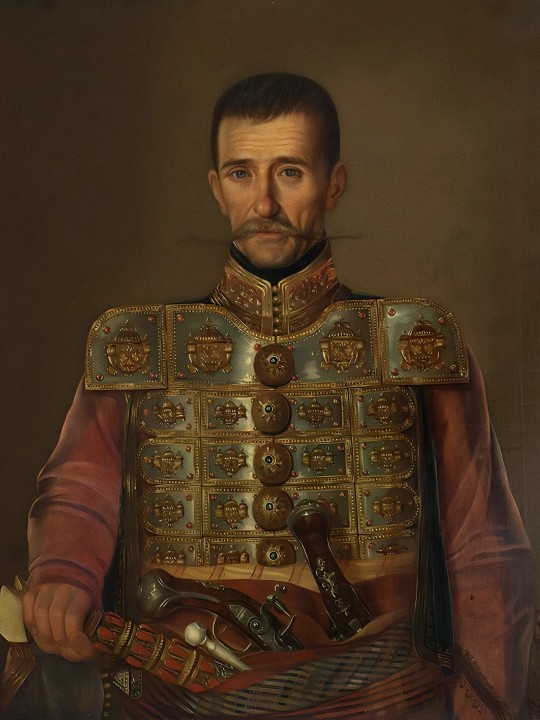
▪️Voivoda Blagoye Zhabarats & Yanko Popovitsh (srb. Војвода Благоје Жабарац и Јанко Поповић)

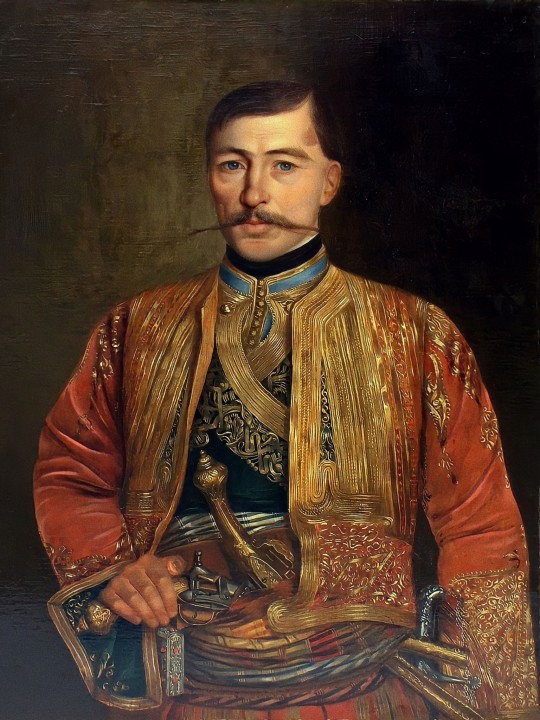
▪️Vasa Charapitsh & Yanitshie Dyuritsh(srb. Васа Чарапић и Јанићије Ђурић)

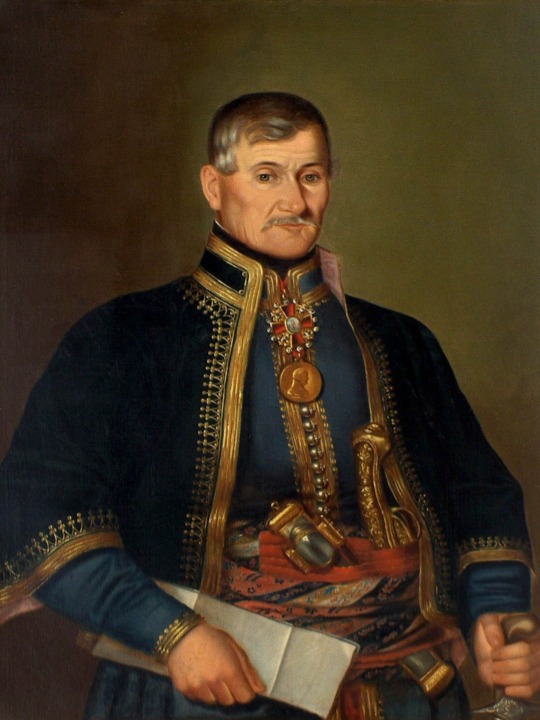
▪️Luka Lazarevitsh & Mladen Milovanovitsh(srb. Лазар Лазаревић и Младен Миловановић)
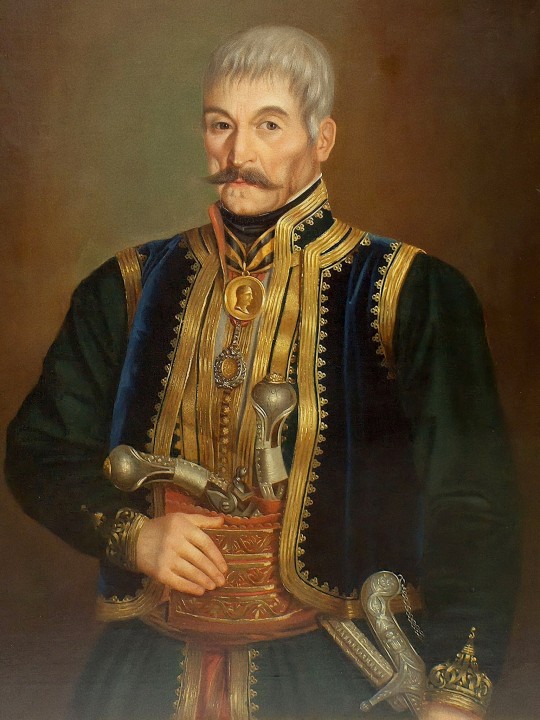

▪️Yakov & Aleksa Nenadovitsh (srb. Јаков и Алекса Ненадовић)
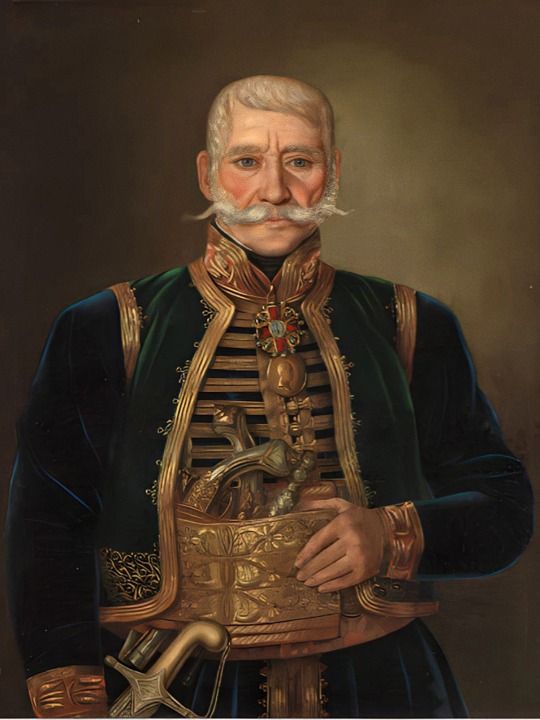

#serbian#balkan#europe#serbian traditional clothes#serbian folklor#Serbian warriors#Voivodas#Serbian revolutionaries#Serbian revolution#18th century#19th century#Dinaric#Phenotype#Vasa Čarapić#Mirko Apostolović#Hajduk Veljko Petrović#Blagoje Žabarac#Janko Popović#Janićije Đurić#Prvi srpski ustanak#1804#South slavs
62 notes
·
View notes
Text
Being Serbian and not religious is complicated enough, but being queer on top of that is even more complicated and that's concerning.
You see, Serbs have a very unique history and bond with religion. Serbia was under Ottoman rule from the middle of the 15th century up until the begging of the 19th century which is a long long time. Being a part of Ottoman empire meant that they wanted to assimilate you and there were many awful things they did due but i won't go into that rn. What was weird about Ottoman empire compared to other oppressors was that they never banned different religions. Obviously your life would have been easier if you became muslim but it wasn't like they killed you for not doing that as Romans did. So Serbian people became very close to the church and it bound all of the folk customs and holidays to itself and saved them which is a great thing and I'm so thankful for that but nowadays it's impossible to separate them. Every aspect of culture is somehow made christian and Serbian people have accepted orthodox christianity as a part of their national identity. You can't imagine how many people I've met who were confused about how can someone be Serbian if they're not christian. And most of them don't even believe in God or what christianity preaches, it's a national identity for them. They can't imagine what Serbs actually are beyond the religion and it's sad.
Other important thing is that all of the holidays and customs are pagan. They have been pagan and then Serbs got christianised in a quick way which means that they just masked the paganism in chriatianity and called it a day. There's practiced whichcraft in Serbian orthodox christianity and people refuse to call it that because it's a normal christian thing for them. There's prayers, healing watter and oils, plants, various rituals for various days (not just Easter and Christmas but even those are completely different than how other christians celebrate them), there's days where you don't work or do certain things so that you don't get God angry, there's future predictions by looking in a cup or reading in the coal or hot iron and various other customs and beliefs. And no one accepts them as anything but chriatian.
So yeah separation of religion and nationality is crucial for Serbian people to move forward but it's also very hard to do and it's beneficial to the government so no one is doing anything about it. Nationalism is unfortunately on the rise among Serbian people and obviously christianity is also. There's people who are ready to fight for "holy places" and Serbian (read christian) values. There's diaspora that's trying to reconnect with their nationality and they just fall into christianty and nationalistic propaganda and it's awful. Most of these people are cowards so I have hope they won't do anything stupid as starting another war but it's still concerning. When your national identity is so strongly bound to christianty a threat to christian beliefs is a threat to your nationality and you already know who falls into that "threat" category.
Also, pagan slavic spaces got infected by fascists and white slavic supremacist? It's like what happened in nordic pagan spaces. I know I know it makes no sense for south slavs to be fascists when ww2 fascists targeted them but you have to understand that these people aren't smart enough to understand that and are egoistic enough to twist things to better suit their beliefs.
That's why queer Slavs and queer folk art and queer history of slavs is so important and even revolutionary in times and places like these. And of course this post is not against christians. One of my favorite things are loving non bigoted christians, especially if they are queer themselves.
41 notes
·
View notes
Text
THIS DAY IN GAY HISTORY
based on: The White Crane Institute's 'Gay Wisdom', Gay Birthdays, Gay For Today, Famous GLBT, glbt-Gay Encylopedia, Today in Gay History, Wikipedia, and more … January 11


1755 – Alexander Hamilton, 1st United States Secretary of the Treasury (d.1804); One had to wonder what the current occupants of the White House would think if they knew of the ruckus caused a couple of centuries ago by Alexander Hamilton and George Washington, the American patriots who became the first secretary of the treasury and president, respectively.
George, whom everyone knows had no children of his own, surrounded himself with a circle of young male revolutionaries who he called his "family." Among his favorites were John Laurens, who once fought a duel to defend George's honor sullied by some cad now lost to history; and Alexander Hamilton. George was thought by his enemies to be a bit soft on the boys and was suspected over being overly fond of young Hamilton in particular.
While in Washington's service Hamilton befriended a group of other young officers, with one of whom, John Laurens of South Carolina, he had a particularly close relationship. When the two were apart on separate assignments, they exchanged affectionate letters. In September 1779, gently chiding Laurens for not corresponding as often as he would have liked, Hamilton wrote, "like a jealous lover, when I thought you slighted my caresses, my affection was alarmed and my vanity piqued."
Between 1779 and 1782, Hamilton and Laurens exchanged a series of love letters, reprinted in Jonathan Katz's Gay American History, in which Laurens addressed Hamilton as "'My Dear' and offered flowery protestations of undying affection, to which Hamilton responded with the touching declaration: "'I love you'." To this day the letters are explained away on the grounds that 18th century men "were classical scholars whose thoughts and actions were colored by the grandeur of antiquity."
Despite the prestige of his appointment on Washington's staff, Hamilton wished to serve in combat like—and perhaps with—his friend Laurens. Using the pretext of a minor disagreement with the general, Hamilton requested and received a transfer in February 1781. The incident left no hard feelings on either side.
Hamilton and Laurens participated in several military campaigns together later that year but were again separated on August 15, 1782, when Hamilton wrote to his friend, addressing him as "My Dear Laurens." Looking beyond the successful conclusion of the war, Hamilton suggested that both of them should be members of the congress of the new country. "We have fought side by side to make America free, let us hand in hand struggle to make her happy," he wrote in a letter ending, "Yours forever."
It is doubtful that Laurens ever read this letter, for he was killed in a skirmish on August 27. Upon hearing of his friend's death from Major General Nathanael Greene, Hamilton wrote back that he felt "the deepest affliction at the news," adding, "I feel the loss of a friend I truly and most tenderly loved."

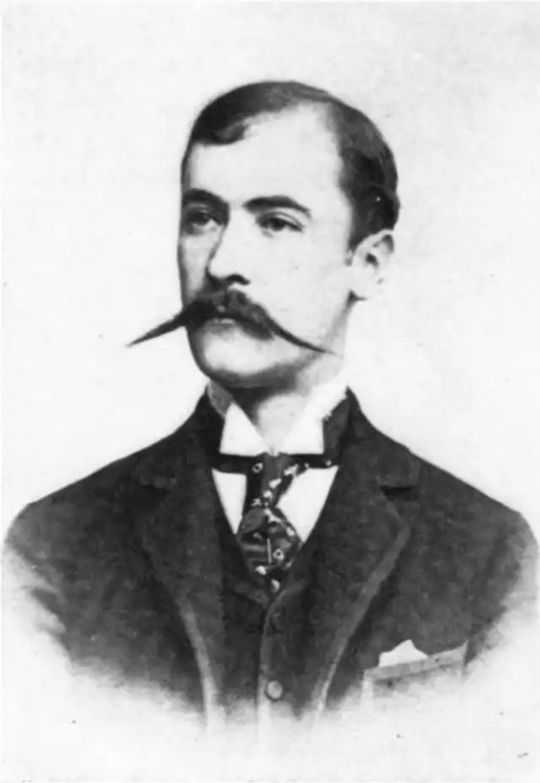
1868 – Prince Bojidar Karageorgevitch (d.1908), Serbian artist and writer on art, was a member of the Serbian House of Karaorđević. He was a world traveller. He gave singing and drawing lessons and later earned his living as an art critic and translator. He was a contributor to the Encyclopædia Britannica, Figaro, La Revue de Paris, Revue des Revues, Magazine of Art, and other publications.
Prince Bojidar lived in France for most of his life as this family were in exile. Bojidar travelled a lot and went on a number of trips around the world. He served in the French Army and fought in the French campaign at Tonking and was decorated with the Cross of the Legion of Honour. To earn a living he gave singing and drawing lessons before becoming a translator and journalist
During one of his trips abroad, he travelled extensively around India, visiting thirty eight cities. He wrote a book about his experiences called Enchanted India in which he offered an account of the Indian people, their religious rites, and other ceremonies.
He was drawn to the cabarets of Montmarte, the haunt of artists, writers, poets, philosophers. It was there he met and befriended French stage actress Sarah Bernhardt, pioneer of modern dance Loïe Fuller, French poet, novelist and noted orientalist Judith Gautier, Suzanne Meyer-Zundel, Austrian composer Hugo Wolf, painter and illustrator Henri de Toulouse-Lautrec, and founder of the Ballets Russes Sergei Diaghilev.
His lover was painter Jules Bastien-Lepage, fourteen years his senior, who predeceased him when Prince Bojidar was only 22 years old. The artist, long ailing, had tried in vain to re-establish his health in Algiers. He died in Paris in 1884. Prince Bojidar, was with him at the end and wrote,
"At last he was unable to work anymore; and he died on the 10th of December, 1884, breathing his last in my arms. At his grave's head his mother and brother lovingly planted an apple-tree, which every spring showers down its wealth of pearly petals over the last resting-place of the great master whose loss we all mourn."


1962 – Today's the birthday of Welsh politician Chris Bryant. Born in Cardiff, Wales. He studied English at Oxford University and theology at Rippon College, Cuddesdon.
Bryant is openly gay, but he was ridiculed in the press when he was discovered to have a Gaydar profile featuring pictures of him wearing only underpants, whilst an MP. In an interview with Attitiude magazine he later described the incident as 'very, very, very, very unpleasant ... I didn't sleep much for about three months.'
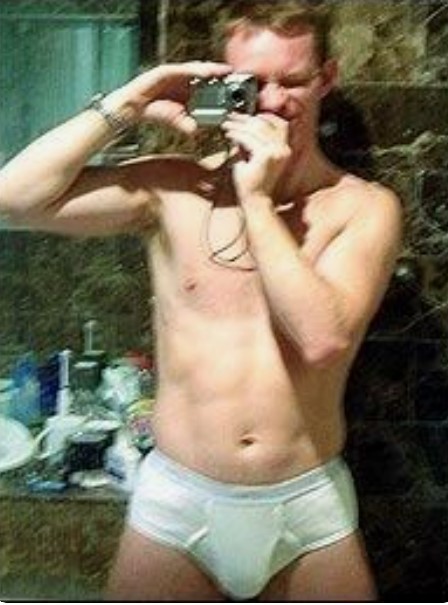
Chris Bryant's "Gaydar" picture.
He later appeared looking very buff in swimming trunks at a parlimanetary swimming fundraiser.
In early 2010 Bryant 'married' his partner Jared Cranney in the first civil partnership to be held in the Houses of Parliament.


1966 – Today is also the birthday of American writer Marc Acito. Born in Bayonne, New Jersey, his comic novel How I Paid for College won the Oregon Book Awards' 2005 Ken Kesey Award for Best Novel, and was voted a 2005 "Teens Top Ten for Favorite Young Adult Book" of the American Library Association. He is also the writer of the syndicated humor column "The Gospel According to Marc", which ran for four years in nineteen gay publications. His humorous essays have appeared in many publications including The New York Times and Portland Monthly magazine; as well as on NPR's All Things Considered.
Acito is openly gay and lives in Portland, Oregon with his partner Floyd Sklaver.


Click for Full Monty)
1972 – Chad Donovan is an American performer and director of gay pornographic films. He has won numerous awards as a performer and director, and is a member of the GayVN Awards Hall of Fame and the Grabby Awards Hall of Fame.
Donovan was born into a Southern Baptist family. His rigid religious background and sexual precocity led to experimentation at an early age. "My first experience with a guy was about eight, just playing around and fingering buttholes. We probably didn't even get hard." Donovan's large endowment prompted teasing from his classmates as he reached puberty. "Through high school I had a difficult time because I had to change clothes for gym and stuff. I nearly failed gym class because I didn't want to change clothes. I got made fun of. Plus, not to mention, I hit puberty at ten. So all these little boys were bald as a peacock and here I am, full out baby's arm holding an apple."
Donovan was introduced to the gay pornographic industry by performers Chase Hunter and Tony DeAngelo. They worked as strippers at a 1470 West, a gay bar in Dayton, Ohio where Donovan was bartending. "We were kind of fucking around, having threeways occasionally. They took pictures of me, sent pictures all around," he recalls. Gay adult studios Catalina Video and Falcon Studios showed interest, and Donovan chose to work for Falcon. He was eighteen years old.
Donovan earned a $2,000 scene rate for his first movie. "When you're a kid living in Ohio, that's a lot of money. And a trip to San Francisco for three days. I did the one scene and two photo layouts. It was fantastic. What more could you ask for?" He filmed the scene with Hunter Scott and Anthony Moore. The scene was released by Falcon in 1994 in the film "Workin' Stiff." Donovan went on to film roughly 50 titles as a performer over the next decade.
In 2001, Bob East of Men of Odyssey broached the idea of directing. "He asked me if I'd be interested in directing. He said I seemed to have a good knack for finding talent, I've been in the industry long enough, why don't I try putting a movie together? So I did." That film was titled "Movin' On," and it was during production that he met and began a relationship with cast member Antonio Madiera, which continues to this day. "I had no intention of getting a boyfriend out of it. I hired the kid, I really liked the way he looked, he performed like a champ, and every time I looked down—when I wasn't even shooting him, I'd be shooting other boys in a scene—he'd be looking up at me with these puppydog eyes. I just couldn't resist."
Donovan's final onscreen sexual performances (as of December 2007) were in 2004. One of those films, "Studs 'N Pups" for MSR Videos, was the first time he and boyfriend Madiera performed together. Madiera continues to act occasionally, usually in films that Donovan directs. In 2007, Donovan helmed Basic Plumbing 3 for Falcon Studios; the film starred Chase Hunter and brought them back together 16 years after Hunter introduced Donovan to the industry. Although essentially retired as a sexual performer, Donovan occasionally appears in nonsexual roles. His early roles remain in circulation as they are continually repackaged into compilation tapes.


1974 – Max von Essen is an American stage and screen actor, and vocalist.
Raised on Long Island, von Essen is a graduate of South Side High School in Rockville Centre, New York. He attended the University of North Carolina at Chapel Hill, and after graduation toured with Liza Minnelli. He is a member of the Von Essen family, who are part of the German and Swedish nobility. A son of Rita and Thomas Von Essen, who was the New York City Fire Commissioner during the 9/11 terrorist attacks on the World Trade Center, he is the youngest of four children. He is openly gay.
He toured Europe in West Side Story and was a cast member of the U.S. national tour of Chicago. He made his Broadway debut in Jesus Christ Superstar in 2000 as Disciple and Jesus of Nazareth understudy. He appeared in Les Misérables on Broadway as the replacement for Fauchelevent and other roles, and starred in Dance of the Vampires alongside Michael Crawford in 2002. He played the role of student revolutionary leader Enjolras (replacement) in the Les Misérables Broadway revival in 2006 at the Broadhurst Theater.
In 2006, he was a soloist at the biggest Andrew Lloyd Webber musical gala to date, held in Tallinn, Estonia. He performed in the national tour of Xanadu as "Sonny" in 2008[8] and in the Roundabout Theater Company Off-Broadway production of Maury Yeston's Death Takes a Holiday at the Laura Pels Theatre in 2011. In 2015, von Essen played the role of Parisian aristocrat Henri in the Broadway production of An American in Paris, for which he received a Tony Award for Best Featured Actor in a Musical nomination.
Max von Essen is now a star of the off-Broadway play “Yours Unfaithfully,” and lives with his partner, Daniel Rowan, in a Hell’s Kitchen duplex.


1976 – Today is also the birthday of American singer Dylan Rice. He graduated from Northwestern University in 1998 (where he studied poetry) and now lives in Chicago. In 2004 he released an album called Wandering Eyes.
In July 2006, Dylan, who is openly gay, performed his stadium-rock anthem "The Faces of Victory" for 20,000 people at the Gay Games Closing Ceremonies at Wrigley Field in Chicago, joined onstage by Styx bassist Chuck Panozzo, and backed by a chorus of Chicago LGBT rockers. Written especially for the Gay Games, the song was also recorded in the studio with Panozzo, released as a single, and was highlighted in the official Gay Games VII commemorative DVD in December 2006.
For more information about Rice, visit his website at www.dylanrice.com Under the "Music" tab you can even download some of his songs.

1984 – The Wall Street Journal allows staff writers to now use the word "gay" as a synonym for "homosexual" in article and headlines.


2012 – In Life with Archie #16, Archie Comics' first gay character, Kevin Keller, married his partner.
In the storyline, Kevin returns to Riverdale as an adult after having served in the Army and having recovered from a battle-related injury in Iraq. He eventually ties the knot with Dr. Clay Walker, an African-American rehabilitation expert who helped Kevin regain his ability to walk, in a ceremony presided over by Riverdale's mayor.
Keller first appeared in the venerable Archie series in Veronica #202, published in September 2010, in a story entitled, "Isn't It Bromantic?" In that story, Veronica expresses interest in dating Kevin, but he explains to Jughead that the reason he does not want to date Veronica is because he is gay.
The issue sold out, prompting Archie Comics to issue a reprint for the first time in its 70-year history.
Keller returned in Veronica #205 and then in 2011 headlined his own 4-issue miniseries, Kevin Keller. That series focuses on Keller's life before he arrived in Riverdale, including his struggles in junior high school.
Anti-gay activist Peter LaBarbera sees the whole development as an insidious plot to indoctrinate children.
LaBarbera has fulminated that the storyline is "really manipulative. Of course they are going to have a soldier having a homosexual so-called marriage with a black, so it's interracial, they want to work that in there, which is fine, interracial marriage is good but not between two men, and he was the physical therapist for this soldier so they're really manipulating these kids. Here you are taking something that parents take for granted is wholesome, Archie Comics, and now even that is being turned into a promoter of the radical homosexual agenda."
Of course, what really infuriates homophobes like LaBarbera is precisely what Teresa Theophano noted: comic books serve as a barometer of shifting attitudes toward sexual minorities and thus the mainstreaming of same-sex marriage in a beloved comic strip like Archie Comics is a reflection of increased acceptance of glbtq people.

2013 – African American Marco McMillian is the first openly gay candidate for political office in Mississippi when he announces his candidacy for mayor of Clarksdale, MS. He is slain a month later.


12 notes
·
View notes
Text
War and the transition to capitalism entailed the great amounts of violence that were necessary to dismantle socialist forms of management and belief, full and stable employment (private labour power market), the sell-out of the accumulated and socialised means of (re)production and infrastructure (privatisation). This process resulted in the deaths of approximately 140,000 people, the marginalisation of entire social groups and minorities, class stratification, increasing pauperisation, and intensive migration that has not stopped ever since. The post-socialist transition was structured as a "modernisation" campaign and conducted in compliance with foreign investment agencies and European Union prerogatives. However, one should not forget that the post-socialist transition was effectively organised from within, and was a consequence of the internal fractures of self-management . . .
. . . this process unfolded with a long-term counter-revolutionary transformation of the ideological apparatuses that targeted the memory of socialism and the events surrounding World War II. This is a process that I call the "primitive accumulation of memory" by the state. As previously pointed out, some right-wing historical revisionists have argued that Yugoslavia was totalitarian and, in that way, the Yugoslav people experienced a "double occupation": at first by fascism/Nazism (e.g. Germans, Italians) and then by Titoism/communism (Soviets, Yugoslavs). This situation was resolved by the final hero: the nation, which was affirmed during the ethnic wars of the 1990s. Prior to the 1990s nations were victims subjugated to the cruelty of external forces – be it communism, fascism, Tito, Stalin, Europe, big powers, neighbouring states – however, since the 1990s the nations live in freedom and independence.
In this constellation the historical memory of socialism and World War II had to undergo major changes and everything socialist Yugoslavia stood for had to be ideologically dismantled. Historical and political revisionism thus organised ideological campaigns that "reinvented traditions", which defined nations as eternal, together with the presupposed pre-modern substance and religion. The new–old double bind materialised into the following: Croat–Catholic, Serbian–Orthodox, Bosnian–Muslim, Slovenian–Catholic, and "reinvented" the specific traditions.
Gal Kirn, Partisan Ruptures: Self-Management, Market Reform, and the Spectre of Socialist Yugoslavia, trans. Borut Praper & Gal Kirn
13 notes
·
View notes
Photo

Dear friends , We are happy to announce that ”Socialist Modernism in Former Yugoslavia”, the third photo album/digital guide of @_BA_CU ‘s planned series, is available in 800 copies. Those who are interested in #SocialistModernism are able to order the book on👉🏻 @UrbanicaGroup @ushopamazon distributor page, (Link in our profile☝️) ; link: http://urbanicagroup.ro/ushop/ or AMAZON: https://www.amazon.com/s?me=A33QJE9SPOCVM4&marketplaceID=ATVPDKIKX0DER by selecting the Photo album from among the books listed. (Shipping worldwide with DHL) #SocialistModernism #_BA_CU The photo album includes landmarks of socialist modernist architecture in Former Yugoslavia – from the 1950s to 1980s. Print run 800 Pages 192 +1 Spread/ YUGO-SOC MOD Map Croatian, Serbian and English Size 26×28.5 cm Weight 1.25 kg Designed and published by @_BA_CU Association 1 pic Avala Tower (Telecommunication and observation) Belgrade, Serbia Originally constructed in 1961, rebuilt 2006-2009. Architects Uglješa Bogunović and Slobodan Janjić. 3pic: Gas station Petrol (not in use) Ljubljana, Slovenia, Built in 1968. Architect: Milan Mihelič. 5pic: Ilinden / Makedonium monument (dedicated to the fighters and revolutionaries who participated in the Ilinden uprising of 1903, as well as soldiers-partisans of the Macedonia National Liberation Struggle 1941-1944.) Kruševo, North Macedonia Built in 1974 Artists Jordan Grabuloski and Iskra Grabuloska 7pic: Bosnia-Sarajevo, National TV 1983. Architects: Milan Kušan, Branko Bulić 8 pic: "Three fists", Bubanj Memorial Park, Nis, Serbia.1963. Sculptor Ivan Sabolic 9 pic: Palace of Youth and Sports (Pallati i Rinise dhe Sporteve; Палата омладине и спорта/Palata omladine i sporta, aka "Boro and Ramiz") Pristina, Kosovo Built in 1977 Renovated in 2000 Architect Živorad Janković and Halid Muhasilović 10 pic: Monument to fallen miners - dedicated to the fallen Mitrovica partisan miners during World War II. Mitrovica, Kosovo It was built in 1973 and designed by architect Bogdan Bogdanovic. https://www.instagram.com/p/Cn94Kq3sO0K/?igshid=NGJjMDIxMWI=
44 notes
·
View notes
Text
My hero is Karadjordje. He was a Serbian revolutionary who led the struggle for his country's independence from the Ottoman Empire during the First Serbian Uprising. He is also the founder of the Karadjordjevic dynasty.
Just by looking at pictures of him, you clearly can see a tall, handsome man. With his luscious mustaches and sad eyes, it is more than obvious why he was so popular with Serbian people.
Famous and renowned for his commanding skills, he was feared by almost all of the Turkish soldiers. The way he behaved both on the battlefield and in private demanded obedience and loyalty. He was able to give hope to an average Serbian villager to stand up against a way more powerful army.
The main reason why Karadjordje is my hero is that he laid the foundation of free Serbia, therefore, making it possible for me to be born in a free country. It is because of people like him that I can be loud and proud about my heritage.
3 notes
·
View notes
Text

I suspect people miss my header image and assume its a Greek temple. If you look at the pillars for a second though, you'll see that it's very modern looking, even surreal. It is, in fact, a Serbian monument called "The Mausoleum of Struggle and Victory" from the socialist era. The aesthetic combines Modernism and Neo-Classicism. The photo itself is by Yang Xiao, as part of a series combining artificial lights with decaying socialist-era monuments at night, called "Eternal Monuments in the Dark."
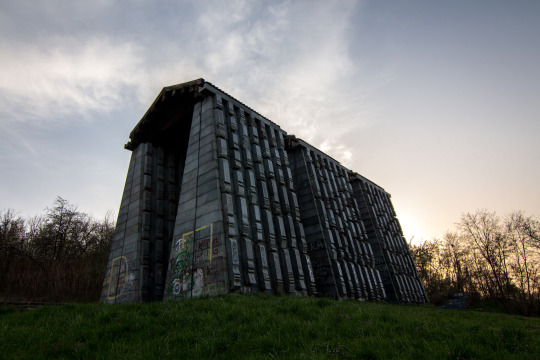
By framing socialist bloc architecture as classical ruins, and placing the democratic revolutions of Greece along side modern socialist revolutions, I'm making a point about historical narratives and associations. Ancient Mediterraneans didn't associate themselves with Northern Europeans, and to this day people are shocked by how "Eastern" Greek culture is. In many ways Islamic culture is more Roman than Western Culture. The Fascist fantasy of the past is just that: a fantasy. A tool they use for their political goals. They homogenize the diversity of Rome, they whitewash Greek statues, and they impose modern Classical music on cultures that wouldn't recognize it.
youtube
Liberals talk about how Ancient Greece is the foundation of Western Civilization™️, but they have no greater claim to it than Muslims or Buddhists. (The Greeks got around.) There is nothing in bourgeois political forms that's reminiscent of Athens, except perhaps for their hypocrisy towards their slaves. Many of the things the peasants and proletarians of Greece and Rome fought for were actively despised by Hamilton, Jefferson, and that whole lot of grifters. They hated universal male suffrage, they hated mass assemblies, they hated ballot measures, they hated rotation and sortition, and they hated land reform and debt abolition. They didn't love "the ancients," they loved their aristocrats.

Socialists have long loved the defeated reformers and revolutionaries of the ancient past. The first modern communist called himself "Gracchus Babeuf." What I'm doing isn't special. The point is to take the things the bourgeois order claims it's built on, and show how fake it all is.
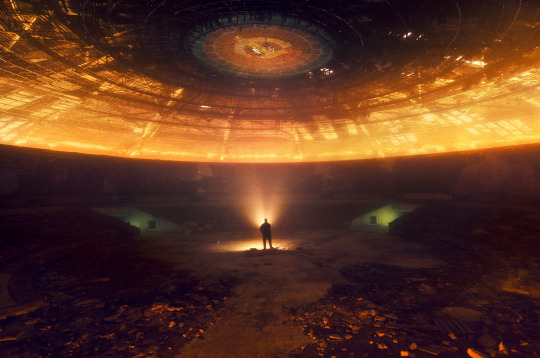
One day, the role the Classical Mediterranean plays in the modern superstructure will be replaced by the Socialist Bloc: a defeated experiment whose ruins global Communism will rest on. Their monuments, now covered in graffiti, will one day be visited by tourists the way the Parthenon is, to marvel at their glorious ambitions.
#socialism#communism#Marxism#history#Ancient Greece#Ancient Rome#architecture#historiography#Youtube#Soviet Union#Serbia
6 notes
·
View notes
Note
i just saw that you were involved in that historical serbian pigeon drama movie post as the space station with the french fake wife guy and i gotta ask, which movies would you recommend i watch that evokes similar emotions such as those in the post, much love 🌸
Off the top of my head:
Aniara: Swedish film adaptation of an epic sci-fi poem written in 1956 about a spaceship full of refugees on a few weeks trip to the moon that then goes wildly off course after running into space debris, turning what was supposed to be a few weeks of travel into a horrifically longer space voyage. Extremely Fucking Depressing, Involves a mind reading machine, cults, and illusions projected onto space itself. Absolutely loved it
A Man Escaped: a 1956 (wow huh made the same year the original Aniara poem was written cool) french black and white film about a revolutionary attempting to escape a French prison. Has a lot of detail and slow, methodical pacing that really puts you into the agonizing moments of slowly sawing through dividers and listening for guards, etc. Really fun mounting tension and escape plan
Savageland (2015) a horror movie told documentary style from someone putting together claims, records, and evidence about a gruesome massacre with only one survivor, its main suspect and also recorder: a photographer who's grisly, disturbing black and white photographs slowly put together a chilling take on a classic horror movie scenario. If you have the stones for a horror film, go in blind.
Finally this one isn't really a movie but it's ABOUT movies: the videogame Immortality! It's a 2022 interactive film video game developed by Sam Barlow, doesn't require any complicated gaming ability really. The game mostly involves clicking through and watching live acted scenes (out of order) of a vanished actressed movie career. Some scenes are final shots, others are rehearsals, bloopers, incomplete, etc. They span 3 movies and the actresses life-up to her mysterious disappearance. Be prepared for dark themes of violence and sexual assault in this one. The real horror of the story comes as you slowly explore each scene in detail, putting together the full story at your own pace and in your own order.
You'll know when you've discovered The Twist though.
4 notes
·
View notes
Text
Events 2.14 (before 1930)
748 – Abbasid Revolution: The Hashimi rebels under Abu Muslim Khorasani take Merv, capital of the Umayyad province Khorasan, marking the consolidation of the Abbasid revolt.
842 – Charles the Bald and Louis the German swear the Oaths of Strasbourg in the French and German languages.
1014 – Pope Benedict VIII crowns Henry of Bavaria, King of Germany and of Italy, as Holy Roman Emperor.
1130 – The troubled 1130 papal election exposes a rift within the College of Cardinals.
1349 – Several hundred Jews are burned to death by mobs while the remaining Jews are forcibly removed from Strasbourg.
1530 – Spanish conquistadores, led by Nuño de Guzmán, overthrow and execute Tangaxuan II, the last independent monarch of the Tarascan state in present-day central Mexico.
1556 – Having been declared a heretic and laicized by Pope Paul IV on 4 December 1555, Archbishop of Canterbury Thomas Cranmer is publicly defrocked at Christ Church Cathedral.
1556 – Coronation of Akbar as ruler of the Mughal Empire.
1613 – Wedding of Princess Elizabeth and Frederick V of the Palatinate at Whitehall Palace, London.
1655 – The Mapuches launch coordinated attacks against the Spanish in Chile beginning the Mapuche uprising of 1655.
1778 – The United States flag is formally recognized by a foreign naval vessel for the first time, when French Admiral Toussaint-Guillaume Picquet de la Motte renders a nine gun salute to USS Ranger, commanded by John Paul Jones.
1779 – American Revolutionary War: The Battle of Kettle Creek is fought in Georgia.
1779 – James Cook is killed by Native Hawaiians near Kealakekua on the Island of Hawaii.
1797 – French Revolutionary Wars: Battle of Cape St. Vincent: John Jervis, (later 1st Earl of St Vincent) and Horatio Nelson (later 1st Viscount Nelson) lead the British Royal Navy to victory over a Spanish fleet in action near Gibraltar.
1804 – Karađorđe leads the First Serbian Uprising against the Ottoman Empire.
1831 – Ras Marye of Yejju marches into Tigray and defeats and kills Dejazmach Sabagadis in the Battle of Debre Abbay.
1835 – The original Quorum of the Twelve Apostles, in the Latter Day Saint movement, is formed in Kirtland, Ohio.
1849 – In New York City, James Knox Polk becomes the first serving President of the United States to have his photograph taken.
1852 – Great Ormond St Hospital for Sick Children, the first hospital in England to provide in-patient beds specifically for children, is founded in London.
1855 – Texas is linked by telegraph to the rest of the United States, with the completion of a connection between New Orleans and Marshall, Texas.
1859 – Oregon is admitted as the 33rd U.S. state.
1876 – Alexander Graham Bell applies for a patent for the telephone, as does Elisha Gray.
1879 – The War of the Pacific breaks out when the Chilean Army occupies the Bolivian port city of Antofagasta.
1899 – Voting machines are approved by the U.S. Congress for use in federal elections.
1900 – The British Army begins the Battle of the Tugela Heights in an effort to lift the Siege of Ladysmith.
1903 – The United States Department of Commerce and Labor is established (later split into the Department of Commerce and the Department of Labor).
1912 – Arizona is admitted as the 48th and the last contiguous U.S. state.
1912 – The U.S. Navy commissions its first class of diesel-powered submarines.
1918 – Russia adopts the Gregorian calendar.
1919 – The Polish–Soviet War begins.
1920 – The League of Women Voters is founded in Chicago.
1924 – The Computing-Tabulating-Recording Company changes its name to International Business Machines Corporation (IBM).
1929 – Saint Valentine's Day Massacre: Seven people, six of them gangster rivals of Al Capone's gang, are murdered in Chicago.
0 notes
Text
On this day in Wikipedia: Friday, 5th January
Welcome, laipni lūdzam, merħba, ласкаво просимо (laskavo prosymo) 🤗
What does @Wikipedia say about 5th January through the years 🏛️📜🗓️?

5th January 2022 🗓️ : Event - Kassym-Jomart Tokayev
Kazakh President Kassym-Jomart Tokayev dismisses Prime Minister Asqar Mamin and declares state of emergency over the 2022 Kazakh unrest.
"Kassym-Jomart Kemeluly Tokayev (Kazakh: Қасым-Жомарт Кемелұлы Тоқаев, romanized: Qasym-Jomart Kemelūly Toqaev [qɑˈsəm ʑoˈmɑrt kʲeˌmʲelo̙ɫɯ toˈqɑjef]; born 17 May 1953) is a Kazakh politician and diplomat who has served as the President of Kazakhstan since 2019. Between 20 March and 12 June 2019, he..."
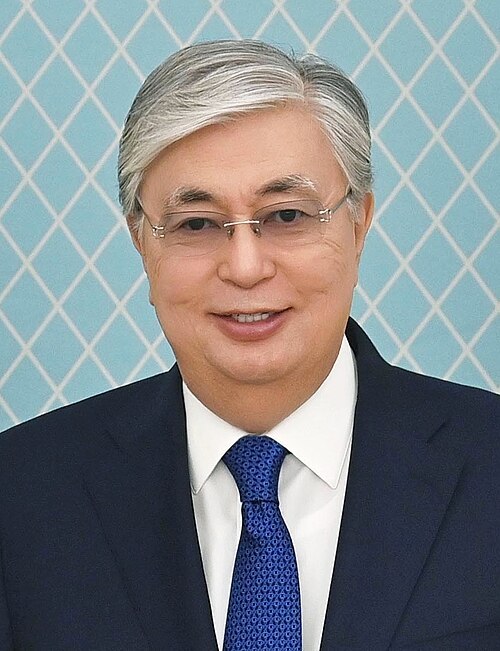
Image licensed under CC BY 4.0? by Unknown authorUnknown author
5th January 2019 🗓️ : Death - Dragoslav Šekularac
Dragoslav Šekularac, Serbian footballer and manager (b. 1937)
"Dragoslav Šekularac (Serbian Cyrillic: Драгослав Шекуларац, pronounced [drǎgoslaʋ ʃekulârats]; 8 November 1937 – 5 January 2019) was a Serbian professional footballer and coach. Nicknamed Šeki, he was quick and crafty with the ball, displaying creative skills which turned many heads. Possessing..."

Image licensed under CC BY 2.0? by Vujcic
5th January 2014 🗓️ : Event - GSAT-14
A launch of the communication satellite GSAT-14 aboard the GSLV MK.II D5 marks the first successful flight of an Indian cryogenic engine.
"GSAT-14 is an Indian communications satellite launched in January 2014. It replaced the GSAT-3 satellite, which was launched in 2004. GSAT-14 was launched by a Geosynchronous Satellite Launch Vehicle Mk.II, which incorporated an Indian-built cryogenic engine on the third stage...."
5th January 1974 🗓️ : Birth - Jessica Chaffin
Jessica Chaffin, American actress, comedian, and writer
"Jessica Chaffin is an American actress, comedian, and writer best known as part of the comedy duo Ronna and Beverly with Jamie Denbo. She is also known for her recurring roles as Coco Wexler on Nickelodeon's Zoey 101, Marie Faldonado in the CBS sitcom Man with a Plan and appearing in the films Spy..."
5th January 1923 🗓️ : Birth - Sam Phillips
Sam Phillips, American radio host and producer, founded Sun Records (d. 2003)
"Samuel Cornelius Phillips (January 5, 1923 – July 30, 2003) was an American record producer. He was the founder of Sun Records and Sun Studio in Memphis, Tennessee, where he produced recordings by Elvis Presley, Roy Orbison, Jerry Lee Lewis, Carl Perkins, Johnny Cash, and Howlin' Wolf. Phillips..."
5th January 1823 🗓️ : Death - George Johnston (British Marines officer)
George Johnston, Scottish-Australian colonel and politician, Lieutenant Governor of New South Wales (b. 1764)
"Lieutenant-Colonel George Johnston (19 March 1764 – 5 January 1823) was a British military officer who served as Lieutenant-Governor of New South Wales, Australia after leading the rebellion later known as the Rum Rebellion. After serving as a young marine officer in the American Revolutionary War,..."
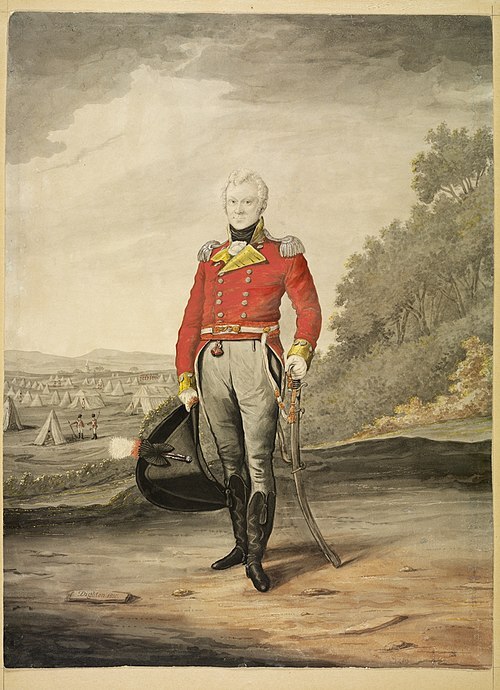
Image by Robert Dighton
5th January 🗓️ : Holiday - Christian Feast day: John Neumann (Catholic Church)
"John Nepomucene Neumann (German: Johann Nepomuk Neumann, Czech: Jan Nepomucký Neumann; March 28, 1811 – January 5, 1860) was a Catholic immigrant from Bohemia. He came to the United States in 1836, where he was ordained, joined the Redemptorist order, and became the fourth Bishop of Philadelphia in..."
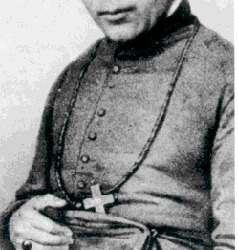
Image by Unknown authorUnknown author
0 notes
Photo
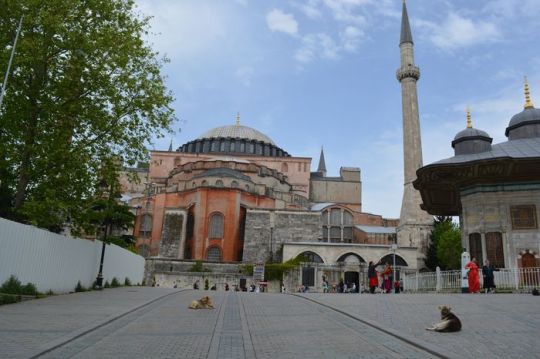
The struggle which turned into a National Revolution
The end of the 18th and the beginning of the 19th century were marked by a decline in the political and economical life in the Ottoman Empire. The successive wars with Russia from 1786 to 1829 led to providing the Tsar’s right of patronizing the Balkan Christians. Despite the aggressive intentions of Russia to lay its hands on the Straits – the Bosporus and the Dardanelles – and gain access to the Aegean Sea, the wars played a positive role for the development of the Bulgarian and the other Balkan national liberation movements. Now the Eastern Question was already regarded in two aspects: the struggle of the peoples enslaved by Turkey for political emancipation and the rivalry among the Great powers for partition of the territorial inheritance coming from the declining Ottoman Empire.
During the first half of the 19th century some Bulgarian refugees left their homeland to form communities in Wallachia, Bessarabia and Southern Russia, and took part in the Russian-Turkish wars. Bulgarian volunteers fought actively in the two successive Serbian uprisings initiated in 1804. Bulgar-ians participated also in the Greek national revolution of 1821-1829. In the 50’s, during the Crimean war, the young Bulgarian revolutionary George Rakovski (1821-1867) – considered as the founder of the organized national liberation movement Holidays Bulgaria – set up a Secret Society in Constantinople whose task was to urge the Bulgarian people to rise in an armed struggle in the course of the military action.
Serbian government
With permission from the Serbian government and with the help of Italian secret societies Rakovski organized the training of a regiment in Belgrade known as the First Bulgarian Legion. Among its soldiers was Vasil Levski (1837-1873) – the future great revolutionary. In 1862 this Legion took part in a clash with the Turks but after a turn in the political relations between Serbia and the Supreme Porte was disbanded. Bitterly disappointed. Rakovski came to believe that liberation should be gained by employing Bulgaria’s own national forces. Later, after the utter defeat of the biggest detachment led by Hadji Dimitar and Stefan Karadja which crossed the Danube to fight the Turks in the summer of 1868, was closed the last page of the detachment tactics’ period of the national liberation movement. The unsuccessful Second Bulgarian Legion formed in the same year proved that too. A new stage in the struggle commenced: an Internal Revolutionary Organization was set up in 1869 under the leadership of the newly established Bulgarian Revolutionary Central Committee. Ahead of this committee stood Liuben Karavelov (1837— 1879), Levski and Hristo Botev (1848-1876).
0 notes
Photo

The struggle which turned into a National Revolution
The end of the 18th and the beginning of the 19th century were marked by a decline in the political and economical life in the Ottoman Empire. The successive wars with Russia from 1786 to 1829 led to providing the Tsar’s right of patronizing the Balkan Christians. Despite the aggressive intentions of Russia to lay its hands on the Straits – the Bosporus and the Dardanelles – and gain access to the Aegean Sea, the wars played a positive role for the development of the Bulgarian and the other Balkan national liberation movements. Now the Eastern Question was already regarded in two aspects: the struggle of the peoples enslaved by Turkey for political emancipation and the rivalry among the Great powers for partition of the territorial inheritance coming from the declining Ottoman Empire.
During the first half of the 19th century some Bulgarian refugees left their homeland to form communities in Wallachia, Bessarabia and Southern Russia, and took part in the Russian-Turkish wars. Bulgarian volunteers fought actively in the two successive Serbian uprisings initiated in 1804. Bulgar-ians participated also in the Greek national revolution of 1821-1829. In the 50’s, during the Crimean war, the young Bulgarian revolutionary George Rakovski (1821-1867) – considered as the founder of the organized national liberation movement Holidays Bulgaria – set up a Secret Society in Constantinople whose task was to urge the Bulgarian people to rise in an armed struggle in the course of the military action.
Serbian government
With permission from the Serbian government and with the help of Italian secret societies Rakovski organized the training of a regiment in Belgrade known as the First Bulgarian Legion. Among its soldiers was Vasil Levski (1837-1873) – the future great revolutionary. In 1862 this Legion took part in a clash with the Turks but after a turn in the political relations between Serbia and the Supreme Porte was disbanded. Bitterly disappointed. Rakovski came to believe that liberation should be gained by employing Bulgaria’s own national forces. Later, after the utter defeat of the biggest detachment led by Hadji Dimitar and Stefan Karadja which crossed the Danube to fight the Turks in the summer of 1868, was closed the last page of the detachment tactics’ period of the national liberation movement. The unsuccessful Second Bulgarian Legion formed in the same year proved that too. A new stage in the struggle commenced: an Internal Revolutionary Organization was set up in 1869 under the leadership of the newly established Bulgarian Revolutionary Central Committee. Ahead of this committee stood Liuben Karavelov (1837— 1879), Levski and Hristo Botev (1848-1876).
0 notes
Photo
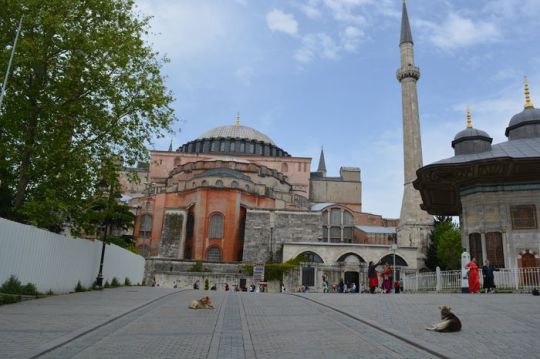
The struggle which turned into a National Revolution
The end of the 18th and the beginning of the 19th century were marked by a decline in the political and economical life in the Ottoman Empire. The successive wars with Russia from 1786 to 1829 led to providing the Tsar’s right of patronizing the Balkan Christians. Despite the aggressive intentions of Russia to lay its hands on the Straits – the Bosporus and the Dardanelles – and gain access to the Aegean Sea, the wars played a positive role for the development of the Bulgarian and the other Balkan national liberation movements. Now the Eastern Question was already regarded in two aspects: the struggle of the peoples enslaved by Turkey for political emancipation and the rivalry among the Great powers for partition of the territorial inheritance coming from the declining Ottoman Empire.
During the first half of the 19th century some Bulgarian refugees left their homeland to form communities in Wallachia, Bessarabia and Southern Russia, and took part in the Russian-Turkish wars. Bulgarian volunteers fought actively in the two successive Serbian uprisings initiated in 1804. Bulgar-ians participated also in the Greek national revolution of 1821-1829. In the 50’s, during the Crimean war, the young Bulgarian revolutionary George Rakovski (1821-1867) – considered as the founder of the organized national liberation movement Holidays Bulgaria – set up a Secret Society in Constantinople whose task was to urge the Bulgarian people to rise in an armed struggle in the course of the military action.
Serbian government
With permission from the Serbian government and with the help of Italian secret societies Rakovski organized the training of a regiment in Belgrade known as the First Bulgarian Legion. Among its soldiers was Vasil Levski (1837-1873) – the future great revolutionary. In 1862 this Legion took part in a clash with the Turks but after a turn in the political relations between Serbia and the Supreme Porte was disbanded. Bitterly disappointed. Rakovski came to believe that liberation should be gained by employing Bulgaria’s own national forces. Later, after the utter defeat of the biggest detachment led by Hadji Dimitar and Stefan Karadja which crossed the Danube to fight the Turks in the summer of 1868, was closed the last page of the detachment tactics’ period of the national liberation movement. The unsuccessful Second Bulgarian Legion formed in the same year proved that too. A new stage in the struggle commenced: an Internal Revolutionary Organization was set up in 1869 under the leadership of the newly established Bulgarian Revolutionary Central Committee. Ahead of this committee stood Liuben Karavelov (1837— 1879), Levski and Hristo Botev (1848-1876).
0 notes
Photo

The struggle which turned into a National Revolution
The end of the 18th and the beginning of the 19th century were marked by a decline in the political and economical life in the Ottoman Empire. The successive wars with Russia from 1786 to 1829 led to providing the Tsar’s right of patronizing the Balkan Christians. Despite the aggressive intentions of Russia to lay its hands on the Straits – the Bosporus and the Dardanelles – and gain access to the Aegean Sea, the wars played a positive role for the development of the Bulgarian and the other Balkan national liberation movements. Now the Eastern Question was already regarded in two aspects: the struggle of the peoples enslaved by Turkey for political emancipation and the rivalry among the Great powers for partition of the territorial inheritance coming from the declining Ottoman Empire.
During the first half of the 19th century some Bulgarian refugees left their homeland to form communities in Wallachia, Bessarabia and Southern Russia, and took part in the Russian-Turkish wars. Bulgarian volunteers fought actively in the two successive Serbian uprisings initiated in 1804. Bulgar-ians participated also in the Greek national revolution of 1821-1829. In the 50’s, during the Crimean war, the young Bulgarian revolutionary George Rakovski (1821-1867) – considered as the founder of the organized national liberation movement Holidays Bulgaria – set up a Secret Society in Constantinople whose task was to urge the Bulgarian people to rise in an armed struggle in the course of the military action.
Serbian government
With permission from the Serbian government and with the help of Italian secret societies Rakovski organized the training of a regiment in Belgrade known as the First Bulgarian Legion. Among its soldiers was Vasil Levski (1837-1873) – the future great revolutionary. In 1862 this Legion took part in a clash with the Turks but after a turn in the political relations between Serbia and the Supreme Porte was disbanded. Bitterly disappointed. Rakovski came to believe that liberation should be gained by employing Bulgaria’s own national forces. Later, after the utter defeat of the biggest detachment led by Hadji Dimitar and Stefan Karadja which crossed the Danube to fight the Turks in the summer of 1868, was closed the last page of the detachment tactics’ period of the national liberation movement. The unsuccessful Second Bulgarian Legion formed in the same year proved that too. A new stage in the struggle commenced: an Internal Revolutionary Organization was set up in 1869 under the leadership of the newly established Bulgarian Revolutionary Central Committee. Ahead of this committee stood Liuben Karavelov (1837— 1879), Levski and Hristo Botev (1848-1876).
0 notes
Photo
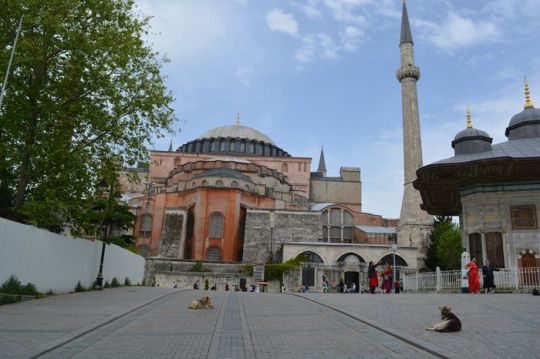
The struggle which turned into a National Revolution
The end of the 18th and the beginning of the 19th century were marked by a decline in the political and economical life in the Ottoman Empire. The successive wars with Russia from 1786 to 1829 led to providing the Tsar’s right of patronizing the Balkan Christians. Despite the aggressive intentions of Russia to lay its hands on the Straits – the Bosporus and the Dardanelles – and gain access to the Aegean Sea, the wars played a positive role for the development of the Bulgarian and the other Balkan national liberation movements. Now the Eastern Question was already regarded in two aspects: the struggle of the peoples enslaved by Turkey for political emancipation and the rivalry among the Great powers for partition of the territorial inheritance coming from the declining Ottoman Empire.
During the first half of the 19th century some Bulgarian refugees left their homeland to form communities in Wallachia, Bessarabia and Southern Russia, and took part in the Russian-Turkish wars. Bulgarian volunteers fought actively in the two successive Serbian uprisings initiated in 1804. Bulgar-ians participated also in the Greek national revolution of 1821-1829. In the 50’s, during the Crimean war, the young Bulgarian revolutionary George Rakovski (1821-1867) – considered as the founder of the organized national liberation movement Holidays Bulgaria – set up a Secret Society in Constantinople whose task was to urge the Bulgarian people to rise in an armed struggle in the course of the military action.
Serbian government
With permission from the Serbian government and with the help of Italian secret societies Rakovski organized the training of a regiment in Belgrade known as the First Bulgarian Legion. Among its soldiers was Vasil Levski (1837-1873) – the future great revolutionary. In 1862 this Legion took part in a clash with the Turks but after a turn in the political relations between Serbia and the Supreme Porte was disbanded. Bitterly disappointed. Rakovski came to believe that liberation should be gained by employing Bulgaria’s own national forces. Later, after the utter defeat of the biggest detachment led by Hadji Dimitar and Stefan Karadja which crossed the Danube to fight the Turks in the summer of 1868, was closed the last page of the detachment tactics’ period of the national liberation movement. The unsuccessful Second Bulgarian Legion formed in the same year proved that too. A new stage in the struggle commenced: an Internal Revolutionary Organization was set up in 1869 under the leadership of the newly established Bulgarian Revolutionary Central Committee. Ahead of this committee stood Liuben Karavelov (1837— 1879), Levski and Hristo Botev (1848-1876).
0 notes
Photo

Dear friends , We are happy to announce that ”Socialist Modernism in Former Yugoslavia”, the third photo album/digital guide of @_BA_CU ‘s planned series, is available in 800 copies. Those who are interested in #SocialistModernism are able to order the book on👉🏻 @UrbanicaGroup @ushopamazon 👈🏻distributor page, (Link in our profile) ; link: http://urbanicagroup.ro/ushop/ or AMAZON: https://www.amazon.com/Socialist-Modernism-Yugoslavia-ASOCIATIA-Association/dp/9730321612/ref=sr_1_1?crid=2VVRKBLETQY2R&keywords=socialist+modernism+in+former+yugoslavia&qid=1660137228&sprefix=socialist+modernism+%2Caps%2C171&sr=8-1 by selecting the Photo album from among the books listed. (Shipping worldwide with DHL) #SocialistModernism #_BA_CU The photo album includes landmarks of socialist modernist architecture in Former Yugoslavia – from the 1950s to 1980s. The preface by prof. Sandra Uskokovic, B.A.C.U. Association explains socialist modernist tendencies, it presents – in color photographs – a functional image of the buildings and their often original elements that synthesize local culture and traditions, while bringing you up to date with their current state of conservation. Print run 800 Pages 192 +1 Spread/ YUGO-SOC MOD Map Croatian, Serbian and English Size 26×28.5 cm Weight 1.25 kg Designed and published by @_BA_CU Association - 1. 9, 10 pic: "Genex Tower" - Western Gates of Belgrade, Belgrade, built in 1977, Architect Mihajlo Mitrović 2 pic: Hotel Zlatibor, Užice, 1981 Architect Svetlana Kana Radevi 3 pic Fighters Workers Battalion Monument on Kadinjača 1979. Užice Designed by sculptor Miodrag Živković and architect Aleksandar Đokić 5pic National Library building. Pristina, 1982. Architect Andrija Mutnjakovic. 7 pic: Ilinden / Makedonium monument (dedicated to the fighters and revolutionaries who participated in the Ilinden uprising of 1903, as well as soldiers-partisans of the Macedonia National Liberation Struggle 1941-1944.) Kruševo, 1974 Artists Jordan Grabuloski and Iskra Grabuloska (c) BACU https://www.instagram.com/p/CmIR8IFoRtw/?igshid=NGJjMDIxMWI=
29 notes
·
View notes